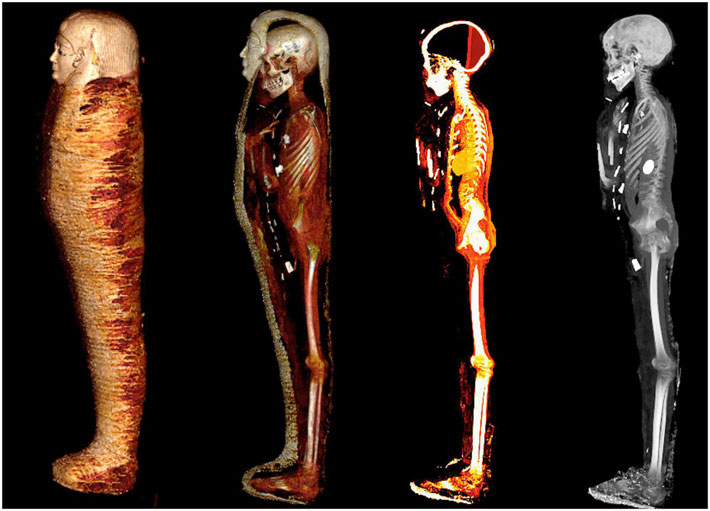 TAHRIR, EGYPT—Ahram Online reports that Sahar Saleem of Cairo University and Sabah Abdel-Razek of the Cairo Egyptian Museum and their colleagues examined the so-called “Mummy of the Golden Boy” with computed tomography scans and advanced radiology techniques. The study found that the 2,300-year-old remains, which were discovered in 1916 in a tomb at Tell Edfu and have been kept in storage at the Cairo Egyptian Museum since then, belonged to a boy approximately 15 years of age at the time of death. He had healthy teeth and bones, and showed no signs of malnutrition. The body had received elaborate care—the brain had been removed, as well as the viscera, although the heart was spotted within the chest cavity. Packing and resin were then inserted in the skull and body cavities. Forty-nine amulets of 21 different varieties, including the Eye of Horus, scarabs, and the Knot of Isis, were placed in three columns in the body cavity and between the folds of the wrappings. Thirty of the amulets were made of gold, while the rest were made of stone or faience. The images also showed that a golden tongue amulet had been placed in the mummy’s mouth. Abdel-Razek said that the intact “Mummy of the Golden Boy” will be put on display at the Egyptian Museum, along with the CT scans and 3-D printed replicas of the amulets. Read the original scholarly article about this research in Frontiers in Medicine. To read about the virtual unwrapping of the mummy of Amenhotep I, go to "Inside a Pharaoh's Coffin," one of ARCHAEOLOGY's Top 10 Discoveries of 2022.
TAHRIR, EGYPT—Ahram Online reports that Sahar Saleem of Cairo University and Sabah Abdel-Razek of the Cairo Egyptian Museum and their colleagues examined the so-called “Mummy of the Golden Boy” with computed tomography scans and advanced radiology techniques. The study found that the 2,300-year-old remains, which were discovered in 1916 in a tomb at Tell Edfu and have been kept in storage at the Cairo Egyptian Museum since then, belonged to a boy approximately 15 years of age at the time of death. He had healthy teeth and bones, and showed no signs of malnutrition. The body had received elaborate care—the brain had been removed, as well as the viscera, although the heart was spotted within the chest cavity. Packing and resin were then inserted in the skull and body cavities. Forty-nine amulets of 21 different varieties, including the Eye of Horus, scarabs, and the Knot of Isis, were placed in three columns in the body cavity and between the folds of the wrappings. Thirty of the amulets were made of gold, while the rest were made of stone or faience. The images also showed that a golden tongue amulet had been placed in the mummy’s mouth. Abdel-Razek said that the intact “Mummy of the Golden Boy” will be put on display at the Egyptian Museum, along with the CT scans and 3-D printed replicas of the amulets. Read the original scholarly article about this research in Frontiers in Medicine. To read about the virtual unwrapping of the mummy of Amenhotep I, go to "Inside a Pharaoh's Coffin," one of ARCHAEOLOGY's Top 10 Discoveries of 2022.
CT Scans Reveal Ancient Egyptian Teenager’s Intact Mummy
